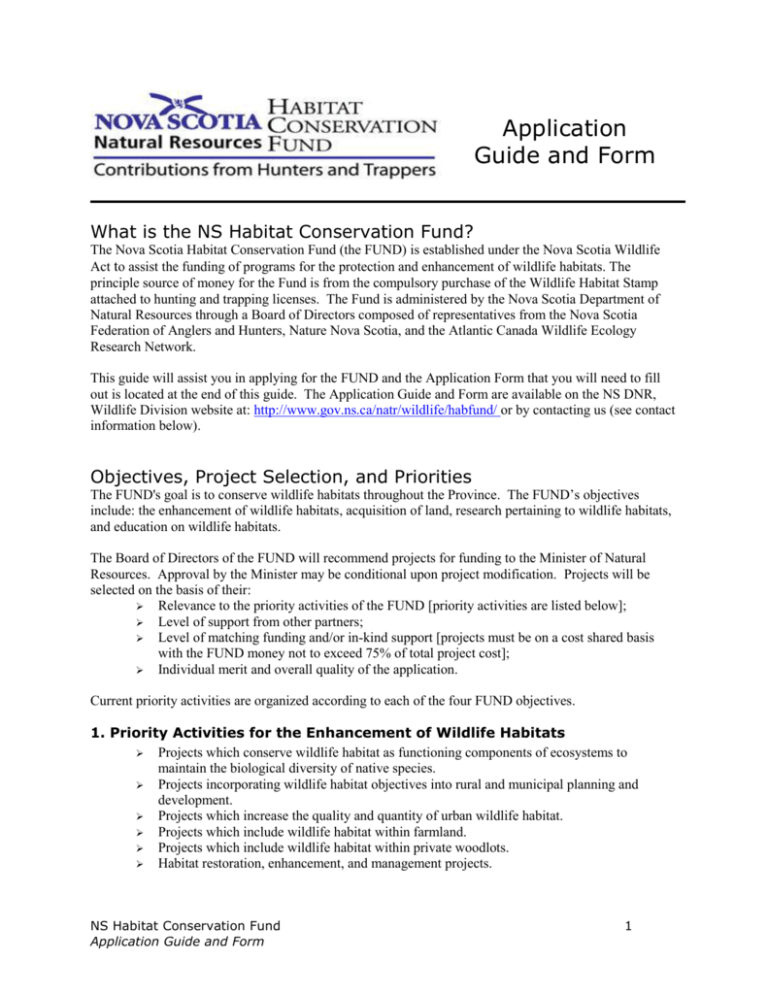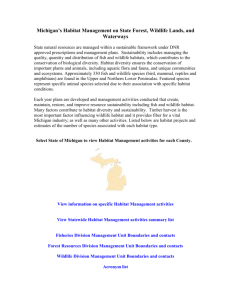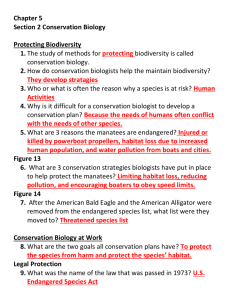What is the NS Habitat Conservation Fund?
advertisement

Application Guide and Form What is the NS Habitat Conservation Fund? The Nova Scotia Habitat Conservation Fund (the FUND) is established under the Nova Scotia Wildlife Act to assist the funding of programs for the protection and enhancement of wildlife habitats. The principle source of money for the Fund is from the compulsory purchase of the Wildlife Habitat Stamp attached to hunting and trapping licenses. The Fund is administered by the Nova Scotia Department of Natural Resources through a Board of Directors composed of representatives from the Nova Scotia Federation of Anglers and Hunters, Nature Nova Scotia, and the Atlantic Canada Wildlife Ecology Research Network. This guide will assist you in applying for the FUND and the Application Form that you will need to fill out is located at the end of this guide. The Application Guide and Form are available on the NS DNR, Wildlife Division website at: http://www.gov.ns.ca/natr/wildlife/habfund/ or by contacting us (see contact information below). Objectives, Project Selection, and Priorities The FUND's goal is to conserve wildlife habitats throughout the Province. The FUND’s objectives include: the enhancement of wildlife habitats, acquisition of land, research pertaining to wildlife habitats, and education on wildlife habitats. The Board of Directors of the FUND will recommend projects for funding to the Minister of Natural Resources. Approval by the Minister may be conditional upon project modification. Projects will be selected on the basis of their: Relevance to the priority activities of the FUND [priority activities are listed below]; Level of support from other partners; Level of matching funding and/or in-kind support [projects must be on a cost shared basis with the FUND money not to exceed 75% of total project cost]; Individual merit and overall quality of the application. Current priority activities are organized according to each of the four FUND objectives. 1. Priority Activities for the Enhancement of Wildlife Habitats Projects which conserve wildlife habitat as functioning components of ecosystems to maintain the biological diversity of native species. Projects incorporating wildlife habitat objectives into rural and municipal planning and development. Projects which increase the quality and quantity of urban wildlife habitat. Projects which include wildlife habitat within farmland. Projects which include wildlife habitat within private woodlots. Habitat restoration, enhancement, and management projects. NS Habitat Conservation Fund Application Guide and Form 1 2. Priority Activities for Land Acquisition Conservation of critical, unique, or high value wildlife habitat through purchase or easement. 3. Priority Activities for Research Pertaining to Wildlife Habitats Alternative methods and approaches to resource development and timber harvesting in forested landscapes, so as to ensure the long-term sustainability of forests as wildlife habitat. Innovative and practical research on habitat and wildlife conservation. Projects which critique provincial, national and international policies impacting wildlife and habitats in Nova Scotia. Design of habitat-related and ecological indicators to monitor the health of habitats and landscapes. 4. Priority Activities for Education on Wildlife Habitats Programs which develop an awareness and appreciation among children and young adults as to the importance of wildlife habitat. Programs which develop an appreciation and understanding of habitat conservation issues among the public and within industry Programs which encourage private landowners to partner and co-operate in managing wildlife habitat. Projects Not Eligible for Funding Please note that, in general, the FUND does not support the following types of projects: Habitat inventories; Tree planting programs (unless a minor part of a broader habitat conservation project); Fisheries management projects; Projects which are a provincial or federal management responsibility; and; Capital costs associated with projects, such as buildings, engineering works, or vehicle acquisition. Funding Normally, projects are not funded for more than $25,000 ($50,000 for land acquisition). The Habitat Conservation Fund will fund projects on a cost shared basis not to exceed 75% of total project cost. Matching funding may include in-kind and/or financial resources, and letters of support from matching funders must accompany the Application Form. In-kind (donated) contributions can be calculated in the following manner: Non-professional volunteer time can be contributed at a rate comparable to the current minimum wage. Mileage associated with the project can be credited at a rate of $0.30/km Donated professional services, facilities, materials and equipment will be valued at fair market prices NS Habitat Conservation Fund Application Guide and Form 2 Eligible applicants Anyone or any organization which is interested in helping with the protection and enhancement of wildlife habitats in Nova Scotia is eligible to apply to the Habitat Conservation Fund. Project Length The maximum length of a project that will be funded is one year. While multi-year projects may be approved in principle, grants will only be awarded on an annual basis. Applicants must submit progress reports and reapply for grants in subsequent years. Application Deadline The completed and signed application form must be postmarked or received by November 30th. Letters of support from matching funding sources must accompany your Application Form. In order to conduct a fair and thorough evaluation of all proposals, the deadline dates for submission of complete proposals must be strictly adhered to. One copy of your application must be sent in by mail so that we have an original signed copy for our files. In addition to written submissions, applicants are requested to submit a copy of the proposal by email to habfund@gov.ns.ca. However, please note that submission by email is NOT required for a complete application. Contact Information Please submit completed and signed application forms to the following address. Habitat Conservation Fund Wildlife Division, Nova Scotia Department of Natural Resources 136 Exhibition Street Kentville, Nova Scotia B4N 4E5 Phone: (902) 679-6091 Fax: (902) 679-6176 Email: habfund@gov.ns.ca Website: http://www.gov.ns.ca/natr/wildlife/habfund/ NS Habitat Conservation Fund Application Guide and Form 3 Conditions for Awarding Habitat Conservation Fund Grants Please familiarize yourself with the following conditions for awarding Habitat Conservation Fund grants. If you have any questions regarding these please contact us. 1. Payments are made in the form of a grant subsequent to the signing of a legal agreement according to the following schedule: a. 50% advance b. 40% interim advance - upon presentation of invoices to cover at least 80% of the first advance. c. 10% final payment - upon presentation of invoices, cancelled cheques to cover the whole project and of final report. 2. It is the proponent's responsibility to account for all project and associated administration costs in budget preparation, including GST and other taxes. 3. FUND grants are awarded on a fiscal year basis (April 1 to March 31). A financial statement will be required at the end of each fiscal year (March 31), and/or within 60 days of project completion. The FUND reserves the right to conduct an audit of the financial records of the applicant. 4. Progress reports must be submitted on a regular basis (as defined in the grant agreement), or as requested by the FUND. 5. The proponent must give the FUND appropriate credit and acknowledge the FUND's financial contribution in any product or any publicity (including articles written about the project by others) relating to the project. This will include use of the FUND's logo where appropriate. A copy must be forwarded to the FUND. 6. Two copies of a final report (one paper and one electronic) must be produced and submitted to the FUND before final payment is received. This report will be posted on the FUND website and should include: (1) project goal and objectives; (2) an outline of the work completed; (3) results; (4) an assessment of achievements and lessons learned, measured against the project goals and objectives; and; (5) recommendations for follow-up steps to the project. NS Habitat Conservation Fund Application Guide and Form 4 Application Form Application Form Instructions: Follow instructions carefully and refer to the Application Guide for additional information. Please provide all of the information requested, type directly into the electronic application form and do not exceed the space allocated, use the text boxes provided and expand only where necessary. Please use 10 pt Arial Font. For handwritten applications please print off this form and write in the text boxes provided. Incomplete applications will not be reviewed. Applications must be received by January 31st. For Office Use Only Date Received: ________________ Project Number: _______________ Fund Objective: ________________ Section 1. Contact Information a) Full name of applicant / organization (Name to be used on legal agreements and disbursements) Name: Website (if available): b) Principal applicant’s name (individual authorizing the proposal on behalf of the organization) Name: Position/Title: Email: Phone: c) Project manager’s name (person who will be the principal project and administrative contact): Name: Email: Phone: d) Address for all correspondence and payments Mailing Address: Postal Code: Fax: NS Habitat Conservation Fund Application Guide and Form 5 Section 2. Brief Project Overview a) Short title of project (1 line max.) b) Duration of project (For “Length” indicate whether this is a multi-year project and if so what year you are in; e.g. Year 1 of a 2 Year Project) Start Date: End Date: Length: Year __ of a __ Year Project c) Type of Project (Which of the four FUND objectives does this project address? Check all that apply.) Education Enhancement Research ** Land Acquisition □ □ □ □ 1. Will the public have access to the land? 2. Will hunting and trapping be allowed? □ Yes □ Yes □ No □ No Note: **For research project applications you must, in addition to this application form, submit a research proposal and resume of the principal applicant. d) Very Brief project description (5 lines max.; how will this project benefit wildlife habitat conservation) e) Project target area (5 lines max.; Where will this project take place? What region will it cover? If necessary or relevant attach map showing location) f) Fund acknowledgment (5 lines max.; how will the fund’s contribution be communicated ?) NS Habitat Conservation Fund Application Guide and Form 6 g) Funding summary Amount requested from the Habitat Conservation Fund $ Amount from other sources (cash and/or in-kind) +$ Total Value of Project =$ Section 3. Project Details a) Project goal (A goal is an overall purpose, future condition or intent that a person or group strives to attain.) b) Project objectives (Objectives are specific, achievable and timely statements about what you hope to accomplish during the timeframe of your project. They are phrased using action-oriented verbs and specific language about outcomes, target audiences, place and time.) NS Habitat Conservation Fund Application Guide and Form 7 c) Project activities, outcomes, and evaluation (Provide an itemized, point-form description of your project: exactly what will be done, what should result, how you will evaluate the success of these activities, and what percentage of the total budget will be spent on each activity; Use 9pt Arial Font for this table) What you will do (activities)? What should result (outcomes)? How will you evaluate each activity? % of Total Budget e.g. A brush mower will clear cut a series of strips in the area of over mature alder growth. - Rejuvenation of over mature alder covers will improve woodcock feeding habitat. - Clear cut strips will provide temporary singing grounds and serve as good nesting and brood habitat. - Snowshoe hare, ruffed grouse and white tailed deer will benefit from rejuvenated alder growth. - A spring singing survey conducted prior to the cutting will provide a baseline of the number of males present in May 2006, and spring surveys in subsequent years as the project continues should record an increase in the number of woodcock. 45% * Add rows as required; delete examples provided. If handwriting the application please, use table format but attach an additional page if needed. NS Habitat Conservation Fund Application Guide and Form 8 d) Project workplan (Outline the major tasks and general time frames for the project) Task: Period: e.g. recruit volunteers April-June e.g. Conduct field work June-August * Add rows as required; delete examples provided. If handwriting the application please, use table format but attach an additional page if needed. e) Detailed project description (35 line max.; Provide a plain language description of the project; including how the activities above will be undertaken, and how the proposed outcomes will be evaluated and reported. For multi-year projects, explain results already achieved and/or future plans for the project. If applying for a Research Project, as indicated in Section 2 c), you must attach a research proposal) NS Habitat Conservation Fund Application Guide and Form 9 Section 4. Financial Information a) Project Budget By Expenditure Item (Use template to provide the project budget for the fiscal year April 1st - March 31st) FUND $ Other Contributions Total Expense Category Description of Requested Expenditure Item Cash ($) (describe and quantify: e.g. 3 technicians for 10 weeks @ $200 per week; travel 500 kms @ $0.30/km) In-kind ($) Human Resources Travel and Field Expenses Material, supplies, & Equipment Other expenditures (Phone, office supplies, ads, etc…) Administration Totals $ $ $ $ * Add rows as required. If handwriting the application please use table format but attach an additional page if needed. b) Matching/Partnership funding details (list all partners and collaborators) Source Organization / Name Contribution Cash Total $ Description of in-kind support Confirmed? Letter Included In-kind $ * Add rows as required. If handwriting the application please use table format but attach an additional page if needed. NS Habitat Conservation Fund Application Guide and Form 10 Section 5. Applicant Credentials a) Describe your organization’s history and capabilities with respect to the proposed project Note: If applying as an individual proceed directly to b) below (7 lines max.; e.g. what other wildlife habitat conservation projects has the organization or group been involved in and what expertise, resources and linkages exist within the organization or group) b) Brief description of the credentials and the relevant experience of the project leader (20 lines maximum; may include relevant work, professional, and volunteer experience, academic degrees, and other relevant training. If applying for a Research Project, as indicated in Section 2 c), you must attach a resume) NS Habitat Conservation Fund Application Guide and Form 11 Section 6. Signatures I hereby certify that the information provided in this application is accurate to the best of my knowledge and that I am familiar with all the conditions of the Habitat Conservation Fund as outlined in the Application Guide. Principal applicant: Date: Name: Title/Position: Signature: NS Habitat Conservation Fund Application Guide and Form 12







